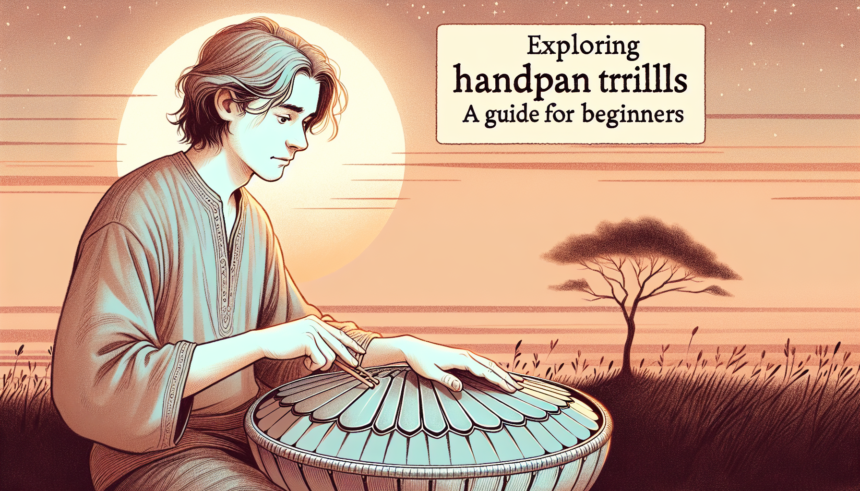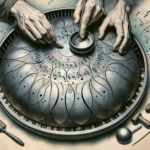The handpan, with its ethereal and meditative sounds, has captivated musicians and listeners alike worldwide. One of the fascinating aspects of playing the handpan is the variety of techniques one can use to create unique sounds and rhythms. Among these techniques, trills stand out as particularly enchanting. If you’re a beginner eager to explore handpan trills, this guide will provide you with an in-depth look at what they are, how to play them, and how to incorporate them into your music.
Understanding Handpan Trills
Trills are a musical ornamentation where two adjacent notes are rapidly alternated. This technique adds a decorative flair to your playing, making your compositions more dynamic and expressive. In handpan music, trills can be used to create beautiful, shimmering effects that can enhance the overall atmosphere of a piece.
Why Learn Trills?
Learning trills can benefit your handpan playing in several ways:
- They add texture and complexity to your compositions.
- They improve finger dexterity and control.
- They enhance your musicality and expressiveness.
- They can be used in various musical styles and genres.
Basic Handpan Playing Techniques
Before diving into trills, it’s crucial to ensure you have a solid understanding of basic handpan playing techniques. Here are a few foundational techniques to master:
1. Striking the Notes
When playing the handpan, it’s important to use the correct striking technique. Use the pads of your fingers rather than the tips to strike the notes gently. This will produce a clear and resonant sound.
2. Hand Position
Maintain a relaxed and natural hand position while playing. Keep your hands slightly curved and avoid tense or rigid movements.
3. Rhythmic Patterns
Practicing basic rhythmic patterns will help you develop a sense of timing and coordination. Start with simple patterns and gradually increase their complexity.
How to Play Trills on Handpan
Now that you have a grasp of basic playing techniques, let’s explore the process of playing trills on the handpan step by step:
1. Identify the Notes
Choose two adjacent notes on your handpan to practice the trill. These notes should be close enough to allow rapid alternation between them. For example, you might choose the central note and one of the nearby notes in the outer ring.
2. Finger Placement
Place your fingers on the selected notes. It’s often easiest to use the index and middle fingers of one hand or the index fingers of both hands.
3. Alternating Finger Motion
Begin by slowly alternating between the two notes, striking each one with your fingers. Maintain a smooth and even motion. The goal is to create a seamless and rapid alternation between the notes.
4. Gradual Increase in Speed
Once you are comfortable with the basic motion, gradually increase the speed of the alternations. Start slow and build up the speed progressively. Focus on maintaining clarity and evenness in the sound.
5. Dynamic Control
Experiment with different levels of force and pressure to vary the dynamics of the trill. You can create softer, more delicate trills by striking lightly or more intense trills by striking with a bit more force.
6. Practice with Metronome
To ensure that your trills are rhythmically precise, practice with a metronome. This will help you maintain a steady pace and improve your timing.
Incorporating Trills into Your Music
Playing trills is not just about the technique itself but how you integrate them into your music. Here are some tips on incorporating trills effectively:
1. Create Musical Phrases
Use trills to add flair to your musical phrases. For example, you can start a phrase with a trill and let it lead into a longer, sustained note. This can create a sense of movement and anticipation in your music.
2. Dynamic Variation
Experiment with varying the dynamics of your trills within a composition. For instance, you can use softer trills during more mellow sections and more intense trills during climactic moments.
3. Combining with Other Techniques
Combine trills with other handpan techniques such as tapping, muting, and gliding to create more intricate and diverse soundscapes. This will make your music richer and more engaging.
4. Improvisation
Incorporate trills into your improvisations to add spontaneity and creativity to your performances. Improvised trills can bring a fresh and unexpected element to your music.
Practice Tips for Mastering Trills
Here are some additional practice tips to help you master trills on the handpan:
1. Start Slowly
Patience is key when learning trills. Begin at a slow pace to ensure accuracy and gradually increase speed as you become more comfortable with the technique.
2. Consistent Practice
Regular practice is essential for developing proficiency. Dedicate a portion of your practice sessions specifically to trills and gradually integrate them into your overall playing.
3. Focus on Clarity
Strive for clarity in each note. Avoid any muddiness or unevenness in your trills by maintaining a steady and controlled finger motion.
4. Listen and Analyze
Record yourself playing trills and listen to the recordings critically. Identify areas for improvement and make adjustments accordingly. Analyze other handpan players’ use of trills for inspiration and learning.
5. Seek Feedback
Share your progress with experienced handpan players or teachers and seek their feedback. Constructive criticism can help you refine your technique and reach higher levels of proficiency.
Benefits of Learning Handpan Trills
Beyond the direct musical benefits, learning handpan trills can have broader positive impacts:
1. Enhanced Focus and Concentration
The meticulous practice of trills can enhance your focus and concentration, which can be beneficial in other areas of your life.
2. Stress Relief
Playing the handpan, including practicing trills, has a meditative quality that can serve as an effective stress-relief activity.
3. Sense of Achievement
Mastering trills can provide a sense of accomplishment and boost your confidence as a musician.
Conclusion
Exploring handpan trills is an enriching journey that enhances your musical expressiveness and technical skills. From understanding the basic concept of trills to mastering the technique and incorporating it into your music, the process can be deeply rewarding. Remember to practice consistently, maintain patience, and enjoy the creative possibilities that trills offer. As you continue to refine your skills, you’ll find that trills can add a captivating element to your handpan performances, captivating both you and your audience.
FAQs
1. What is a trill on the handpan?
A trill on the handpan is a musical ornamentation where two adjacent notes are rapidly alternated to create a decorative and dynamic sound effect.
2. Do I need to learn basic handpan techniques before practicing trills?
Yes, having a solid foundation in basic handpan techniques such as striking notes, hand positioning, and rhythmic patterns is essential before diving into trills.
3. How can I improve the speed of my trills?
Start with slow practice to ensure accuracy and gradually increase the speed while maintaining clarity and evenness in the sound. Use a metronome to help with timing.
4. Can trills be used in composed and improvised handpan music?
Absolutely! Trills can add flair to both composed and improvised handpan music, enhancing the texture and expressiveness of your performances.
5. How often should I practice trills?
Regular and consistent practice is key. Dedicate a portion of your practice sessions specifically to trills, and gradually integrate them into your overall playing for best results.





